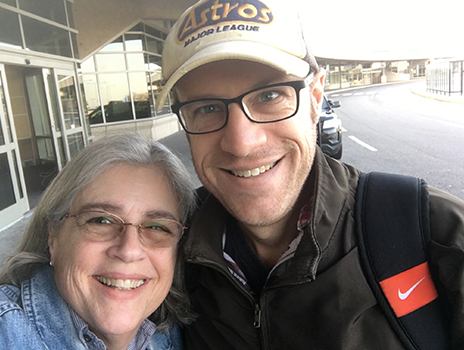- Home
- News Room
- Patient Stories Search Page
- Cancer Free After Comprehensive Hodgkin Lymphoma Treatment
August 13, 2019
Blood and marrow transplantation specialist Siddhartha Ganguly, MD, does not tweet. So when a colleague showed him Mike O’Neill’s heartfelt praise on Twitter, Dr. Ganguly was flattered but modest.
The tweet in question, posted February 27, 2018, read: “Thanks to @KUcancercenter, I’m now officially 1 year cancer free & feeling great. As someone who’s been treated at 5 different hospitals on 2 different continents, I feel qualified to say they are the best & don’t think I’d be alive today if I’d gone someplace else.”
His doctor is quick to point out that Mike was cared for by an entire team of dedicated lymphoma/myeloma professionals at The University of Kansas Cancer Center. And Mike agrees that the entire cancer center team was instrumental in treating his recurrent Hodgkin lymphoma, a cancer of the white blood cells.
“I want people to know how great the doctors and nurses and the whole team are,” Mike says. “Every time I went there, they all remembered my name. They remembered my story.” That story tells of Mike’s long road to the cancer center – one that includes unique challenges posed by a villain called cancer, but ultimately ends as a tale of hope and heroes.
Mike's cancer story begins
Mike’s story began with a desire to see the world.
“I made a plan to go teach English abroad, and my first stop would be South Korea,” he says. In fact, it was his only stop. He stayed in South Korea for 14 years, from 2001 to 2015, working his way up to a head teaching post at one of the nation’s elite secondary schools.
Everything was going well until Mike developed a hacking cough that wouldn’t go away. He felt itchy and experienced night sweats. It was 2014, and Mike was 38 when he was diagnosed with Hodgkin lymphoma. His diagnosis took 6 months, in part because Hodgkin-type lymphoma is unusual in the Korean population.
Hodgkin lymphoma is a cancer of white blood cells known as B lymphocytes. When functioning properly, B lymphocytes create antibodies that fight infection. Hodgkin lymphoma, however, causes the cells to grow abnormally. The disease is typically diagnosed in people between 20 and 40 years old or older than 55.
Doctors at one of South Korea’s most advanced hospitals treated Mike with the standard of care – chemotherapy and radiation. A month after his treatment ended and he was declared cancer-free, Mike and his wife returned to America and settled in Northern Virginia.
Thanks to @KUcancercenter, I’m now officially 1 year cancer free & feeling great. As someone who’s been treated at 5 different hospitals on 2 different continents, I feel qualified to say they are the best & don’t think I’d be alive today if I’d gone someplace else. –Mike O'Neill, via Twitter
Hodgkin lymphoma survivor
More Hodgkin lymphoma symptoms
Within months of his return, however, Mike’s symptoms came roaring back. In the fall of 2015, doctors near Mike’s home on the East Coast discovered the cancer had recurred. This time, the treatment was more aggressive, including an autologous stem cell transplant. “Basically, this is a transplant in which you serve as your own stem cell donor,” Mike explains.
The transplant process involved several steps. First, doctors harvested stem cells from Mike’s blood. Then, high doses of chemotherapy killed off cancerous cells. However, the chemo also killed healthy blood cells, destroying the immune system. Doctors then put Mike’s collected stem cells back into his bloodstream where they gradually produced healthy, new blood cells.
Although the transplant initially seemed successful, the O’Neills’ hopes were dashed when Mike’s symptoms returned. With the second recurrence, Mike knew his treatment options were dwindling, and “the walls were starting to close in.”
Mike needed continued care, but the couple also needed Mike’s wife to continue to work. His parents had traveled from their home in Edgerton, Kansas, to support Mike after his transplant.
“I knew I’d still need their help as I continued treatment, but it wouldn’t be fair to expect them to just keep living with me,” he says. Knowing The University of Kansas Cancer Center was a center of excellence near his parents’ home, Mike opted to continue Hodgkin lymphoma treatment in Kansas City.
Killing cancer with immunotherapy
His doctors remembers the first time he reviewed Mike’s medical record and says it was a challenging case.. Yet he knew there were more weapons available to fight the cancer, and he expressed his optimism to Mike.
“My doctor explained right away that we would have to be open-minded and flexible, and that plans might change during my treatment,” Mike says. “But he was confident, and I could see that he really cared about me.”
In addition to his work seeing patients, Mike's doctor is a respected researcher, collaborating with others across the country to develop and test new lymphoma treatments. Many of the most innovative new therapies are based on a patient’s individual genetic code.
Mike’s cancer care team recommended he receive a targeted immunotherapy treatment. Although it helped reduce the cancer, Mike also needed a second stem cell transplant, but this time stem cells from a donor.
Finding a donor with a perfect tissue match can be difficult, and waiting for that perfect donor can be lethal. Instead, his doctor suggested a haploidentical donor, a close relative whose tissue is a 50% match.
Haploidentical transplants are being performed at an increasing number of academic medical centers such as The University of Kansas Cancer Center. The growing success of these transplants means that almost everybody has a donor now through their parents, children or siblings. As a result, access to stem cell transplants has improved tremendously.
Cancer-free after stem cell transplant
In February 2017, Mike received stem cells from his brother.
“My cancer was persistent, and this was a last throw of the dice,” he recalls. “But here I am. Against all odds, I’ve been cancer-free for more than a year. ”
Mike says the moral of this story: Never give up hope.

